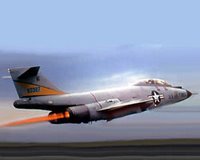
The F-101, "Voodoo", was the second of the so-called Century Series fighters. Starting with the F-100, "Super Sabre" and ending with the F-110, "Spectre", which was later re-designated the F-4, "Phantom II". As you can see from the photo, the rudder and pitch control are on a tail boom behind the engines. Just forward of the tail boom and above the engines, are five fuel "cells" plumbed together to make up the fuselage fuel tank.
To refuel the aircraft, a fuel truck would make a sealed connection to the body of the plane and pump fuel into these cells at a moderate pressure.
(You can watch a similiar operation from the windows of the waiting area of the airport terminal.)
Since the hose connection is air tight, the cells must be ventilated. They accomplished this with ducting from the top of the cells that are connected with "T" fittings so that fuel vapors and air could exit at the back of the tail boom.
In October, 1980, I was into the second day of Air Defense Alert at New Orleans Naval Air Station when the phone rang. Not the "Bat" phone, just a regular land line. New Orleans was not our home base. We deployed there from Houston for a 48 hour shift. We would take off from Ellington Field, have a short training session then recover to the Navy base. I answered the phone, and was told that two of our squadron members had been killed that morning on a training flight. At the time, all we were told, all that they knew, was that the plane had nosed into the ground just a moment after taking off. There was an unconfirmed report of an explosion before it hit the ground. Greg was the front seater, and Jerry was in the back. The eight of us in New Orleans, four crew members and four mechanics, stayed close to the phone for the rest of the day. The thoughts we all had centered around the loss of our friends and the questions of How? Why?
Weeks later,after the investigation, we got our answers. The fuel vent at the tail of the plane had becomed clogged, allowing the refueling pressure to force a clamp, securing a"T" fitting, loose. This let a small amount of fuel to collect in the tail boom. A perfect mixture of fuel and air, all that was needed was ignition.
We never found out what the ignition source was. Something, maybe the afterburner, touched it off. The explosion severed the tail boom. The horizontal stabilizer and the rudder were no longer a part of the plane, pitch control was gone, the nose dropped, and it flew into the ground.
There was some evidence that suggested they had tried to eject, but there was not enough time and altitude. What was also clear, was that this condition had been in place for a very long time. This plane was a time bomb. We had all flown it. In fact, I had flown it the day before the accident on the flight that took me to New Orleans.
No comments:
Post a Comment